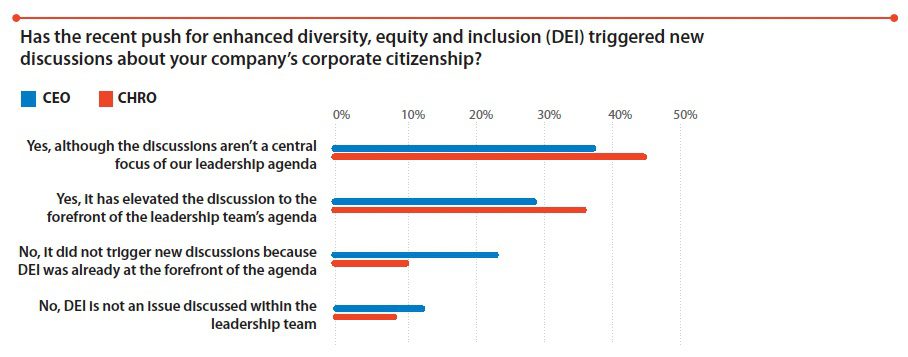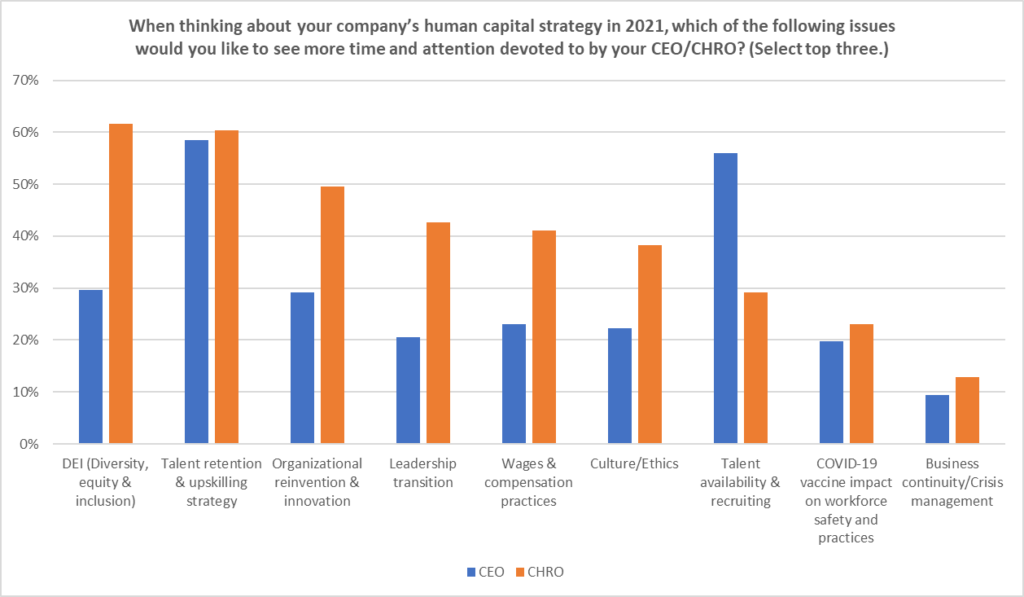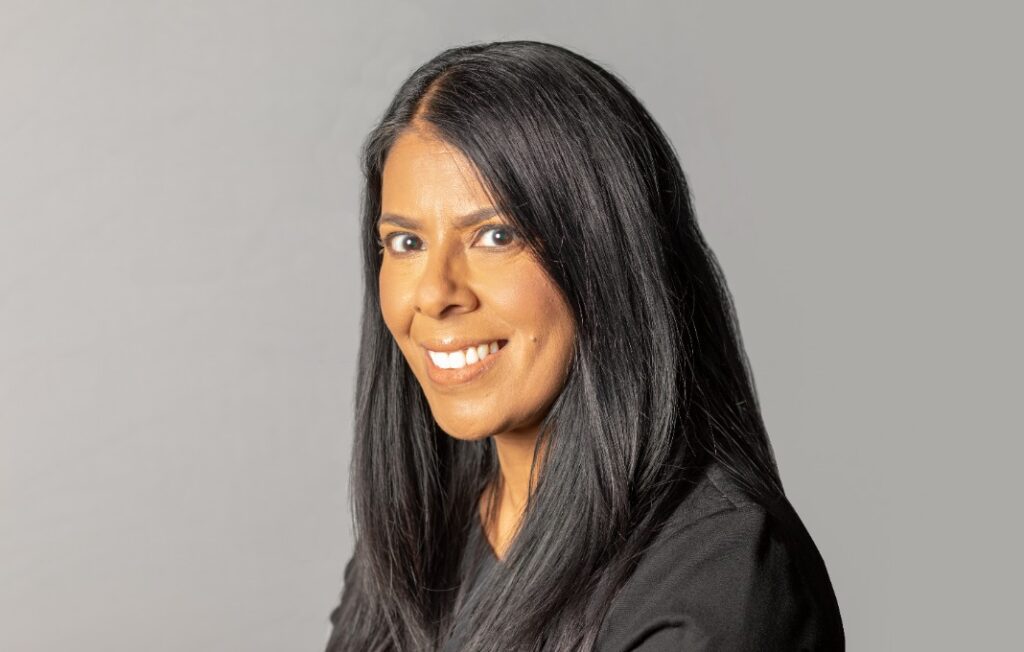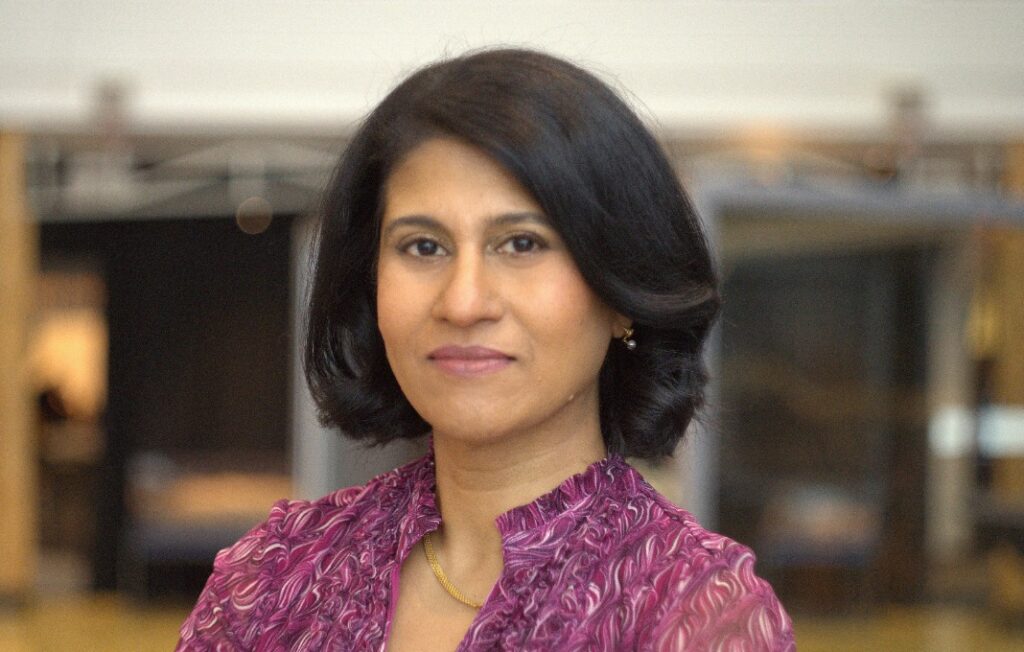Despite the pandemic and economic contraction of the past year, the talent war continues to rage, and CEOs want their human resource chiefs to spend more time finding, retaining and upskilling great employees, according to a new survey by Chief Executive and the Society for Human Resource Management (SHRM). But the survey, which polled 243 CEOs and 406 CHROs, also found CHROs wishing their CEOs spent more time thinking about diversity, equity and inclusion (DEI) strategy. A closer look at the findings suggests that while the differences between CEO and CHRO perspectives are fewer than their areas of agreement, there might be room for improvement around collaboration on talent strategy overall.
Finding and Keeping the Best
From the CEO’s perspective, the survey found the two biggest priorities for 2021 human capital strategy were talent retention & upskilling (58.4 percent) and availability & recruiting (56 percent of CEOs). While CHROs agreed on the former (60.3 percent), only 29 percent of CHROs said they’d like to see more time devoted to talent availability & recruiting.

That may be a matter of emphasis, says Scott Glaze, CEO of Fort Wayne Metals. “The [CHRO] attitude is, ‘We’ve got this, we’re in good shape.’ The CEO doesn’t necessarily know which specific activities the HR group is doing to keep the talent pipeline going.”
Twice as many CHROs (42.7 percent) as CEOs (20.6 percent) prioritized leadership transition for 2021, but when CEOs were asked to choose areas where the CHRO could add more value, the highest percentage (55.4 percent) chose “making better people managers.”

“If you’re a high-growth company like we are,” says Kevin Campbell, CEO of IT firm Syniti, “you’ll continue to try to promote from within, and you’ll end up with a lot of first-time people managers. So that’s something that resonated when I read that question.”
In fact, both CEOs and CHROs rated this category the highest, perhaps recognizing that bad managers lead to labor issues, low engagement, loss of productivity, lawsuits and other negative effects that damage the organization, says Dr. Alex Alonso, SHRM chief knowledge officer. Previous SHRM research has shown that the five-year cost of turnover from toxic managers exceeds $223 billion. SHRM research has also found that three out of four working Americans believe their managers are the biggest factor in establishing workplace culture. However, one in three U.S. workers claim their manager doesn’t know how to lead a team, and nearly three in 10 employees lack trust in their manager to treat them fairly. Another three in 10 workers say their manager doesn’t encourage a culture of open and transparent communication.
Having great managers begins with finding great people, which continues to be a challenge across industries. “We’re having an even more difficult time in the pandemic finding talented individuals, and that’s constantly what we hear from all our senior managers, too,” says John Frye, co-president of insurance firm Investors Heritage. That difficulty is more pronounced for the smallest companies, whose CEOs prioritized finding talent far ahead of other categories. Campbell noted that with remote work more common, retention will be even more of a challenge going forward because geography will be less of a barrier. “I think we’ll see a lot of movement this next year,” he says.
John Williams, chairman and CEO of Jamison Door Company, noted that manufacturing companies have a unique challenge in that the industry has changed, requiring a mix of disparate skills. “Part of it is one step above high school shop class, but the other part is running computerized equipment that costs us $1.5 million and really take some know-how,” he says. “So there’s an image problem of attracting the kind of people who are smart enough to operate that and still work in a factory because the stereotypical factory worker is not at that level.”
Diverging on Diversity
When asked what they’d like to see their CEOs spend more time on, 62 percent of CHROs, the highest percentage, said DEI, compared with 30 percent of CEOs when asked the same question about their CHROs. That may suggest HR chiefs are not getting as much buy-in from their CEOs as they’d like, but it also might indicate that CHROs are more aware of how DEI impacts business outcomes such as retention and engagement, said Alonso. “Issues of inclusion are uniquely intertwined with talent retention and engagement,” he says. “Over the last decade, SHRM has engaged in qualitative assessments to understand what CHROs need when creating greater retention. In just the last decade, the importance of DEI initiatives as a retention and engagement lever has more than doubled.”

Glaze is in the camp of CEOs who agree with the importance of diversity in the workforce, primarily because it supports the community in which his business hopes to thrive. “If you’re invested in the community, you want it to be as strong as possible.” But he has been frustrated with the lack of progress increasing diversity among his 1,300 employees. He recounts talking with with some of the local pastors in the community, one of whom explained that “some people don’t have cars, they don’t have transportation, and unless you’re on a bus line, it’s very difficult for them to get to work.”
Based on that feedback, six months ago, the company opened a new plant located along a bus route. “The idea is to bring people in at much lower barriers to entry and then train them up in that area,” says Glaze. “Once they’re at a level that’s acceptable for any of our other positions, then they can flow into any of our other plants in the area.”
For smaller companies, diversity hiring becomes even more challenging, says Frye, who began his career at the exponentially bigger GE, where new employees are constantly being hired. With fewer new positions open, he says, he can’t afford to focus on anything but skills and fit. “You have a five-person function and you hire the wrong person in there, that can really be a problem,” he says. “Hiring mistakes can really be magnified in smaller companies. So we say, let’s find the best candidate.”
Two-thirds of both CEOs and CHROs said the frequency and depth of conversation about human capital have increased in light of the social events that occurred in 2020. CEOs and CHROs differed slightly on whether the recent push for enhanced DEI has triggered new discussions about corporate citizenship. Both CEOs (37.9 percent) and CHROs (44.4 percent) said it had elevated the discussion, but that it was not the central focus of the leadership agenda; however, 22.6 percent of CEOs said it did not trigger new discussions because DEI was already at the forefront of the agenda, while only 10.2 percent of CHROs said the same. Glaze says the DEI push had intensified the company’s conversations, “and it just affirms what we were doing, but at the same time, we’re looking at other things we can do.” For example, the company has joined United Fort Wayne, which has been addressing the issue of racial equality.
 Asked to rate how well the company is handling inclusion, CEOs generally see more progress than CHROs. For example, the highest percentage of CEOs (26 percent) rated their company’s efforts an eight out of 10, while 17.7 percent of CHROs said the same. Nearly double the percentage of CHROs rated efforts at just a four, or “fair,” compared with CEOs.
Asked to rate how well the company is handling inclusion, CEOs generally see more progress than CHROs. For example, the highest percentage of CEOs (26 percent) rated their company’s efforts an eight out of 10, while 17.7 percent of CHROs said the same. Nearly double the percentage of CHROs rated efforts at just a four, or “fair,” compared with CEOs.
The two survey populations differed on the question of how best to monitor potential problems in the culture. Both CEOs and CHROs cited turnover data, employee surveys and one-one-one discussions as key tools, but 57 percent of CHROs named hotlines as a primary method, while only 40.3 percent of CEOs said the same. “Because, in my view, by the time it gets to the hotline, it’s too late,” says Campbell.
Maintaining culture was named by both CEOs and CHROs as the top challenge to a remote work environment. “When you’re in an office, you can walk around and chat people up, so people feel connected,” says Frye. “So making sure people feel connected and feel part of something and want to be part of that—that’s my biggest challenge.”
 CEOs may also want to consider getting their HR chiefs better access to data: just over half of CHROs believe they could offer more value to the CEO by leveraging people data to prevent significant workplace culture issues, but only 28 percent of CEOs named that as a priority.
CEOs may also want to consider getting their HR chiefs better access to data: just over half of CHROs believe they could offer more value to the CEO by leveraging people data to prevent significant workplace culture issues, but only 28 percent of CEOs named that as a priority.
 The Changing Role of HR
The Changing Role of HR
One clear area of agreement between CEOs and CHROs: the expanding role of the HR manager as a strategic partner to the CEO. “CEOs and CHROs have shifted over the years on this leadership conundrum,” says Alonso. “As the importance of talent operations has risen, so has the criticality of a good CHRO and the involvement of CEOs in creating an attractive workplace. The two go hand-in-hand if HR is to unlock the human potential needed for success in a highly personalized talent market.”
A little more than three out of four CEOs said they look to their HR chiefs for views on business strategy and operational issues planning, though that still came in last of four other areas of value CEOs want to see their CHROs provide.

Harvey Kanter, who has been CEO of retailer DXL Group for the past two years, noted that he recently elevated his VP of human resources, who used to report to the chief administrative officer and general counsel, to the role of CHRO, and she will now report directly to him. “Developing our culture and our talent is an incredibly strategic role, as opposed to just executing the tactical human resource plan or function,” he says.
Indeed, the traditional tasks of human resources have become “table stakes,” says Frye. “We need to learn to develop people.” He noted that the current HR manager was hired several years ago to handle benefits, payroll, etc., but not necessarily to provide input on strategy. “That doesn’t mean he can’t get there,” says Frye. But for now, the company has hired an outside HR consultant to serve in that role and mentor and develop the current HR manager to be able to serve in that strategic advisor role. “You have to develop your people and, yeah, that makes them more attractive on the outside, but that’s fine. It’s absolutely what we should be doing.”








